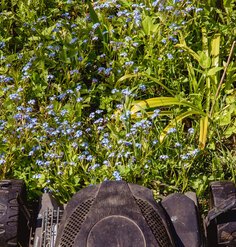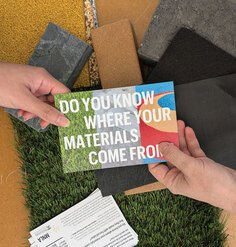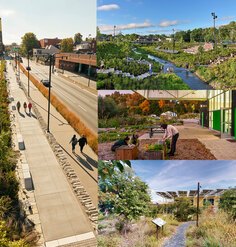From the Field: Preparing Researchers for Practice
Research Fellow Mary Pat Mattson and student Research Assistant Rachel Guinn are participating in LAF’s 2013 Case Study Investigation (CSI) program. Rachel Guinn is an MLA Candidate in the College of Architecture at the Illinois Institute of Technology where Mary Pat Mattson is a Studio Assistant Professor. They have been evaluating and documenting the performance of three Chicago-area landscape projects. IIT’s Mary Pat Mattson interviewed Research Assistant Rachel Guinn about her experience.
What interested you in becoming a researcher for LAF’s Case Study Investigation program?
I was interested in participating in CSI to learn about what landscapes do after they are installed, and I was especially excited to study local landscapes here in Chicago. Far too often, landscape is talked about as a static thing, so the opportunity to investigate the “living, breathing” aspects of landscapes really interested me.
Were you already familiar with concepts and methods of ‘landscape performance’?
What I have learned from CSI is how diverse and infinite landscape performance is, which makes it very difficult to quantify concisely. Ecologic benefits are complex simply because ecologic processes do not stop at property boundaries, so understanding the effects of and influences on a landscape project is quite an undertaking. Social benefits are notoriously difficult to quantify because so many effects of landscape are qualitative and subjective. Economic benefits may appear to be simple, but given the diverse ways that projects and their maintenance get funded and the many people involved, it is not always clear where and what the costs of sustainable landscapes are. CSI has given me an appreciation of what an endeavor it is to study the benefits of landscapes, but how valuable that information is.
What did you find most rewarding in your research process? Were there any surprises or big hurdles to overcome?
The most rewarding aspect has been getting to thoroughly “know” projects by talking with the people who helped them come about, coming to understand the lifespan (up till now) of the projects — how they began as design goals, how they have changed over time as needs altered and issues cropped up. It has given me an even deeper appreciation of the time and effort that developers, landscape architects, architects, landscape contractors, invest in creating landscapes that function at the highest levels.
Being on the “interviewer” side of conversations was difficult. As a design student, I was used to being asked questions about a project, but turning the tables and asking the questions requires understanding on a whole other level. It was so important to be prepared to ask the right questions to maximize the outcome of interviews.
Can you describe something that links the three projects you’ve studied?
All of the projects we studied in CSI used landscape as an educational tool, whether through stewardship (63rd Street Beach), programming (the Smart Home exhibit), or visibility of ecologic processes (Advocate Lutheran General Hospital). I think education is often part of successful projects because it engages people directly, and the more people notice their environments, the more they will care for them and ensure the project’s continued success. Learning about individuals’ stewardship for these respective projects has been a remarkable and rewarding discovery.
Is there a project, or aspect of a project, you wish you could continue to explore?
I have read about Chicago’s water quality issues and seen beach closures for years. While researching 63rd Street Beach, I found a plethora of research conducted at this location, which has been known for its particularly high levels of E.coli. Sources of the pollution range from sewer outflows to seagull populations to human use. It would be great to continue to study how, if at all, the creation of dunes at the beach has helped to improve water quality — if the naturalized landscape makes people more aware of their impacts on the environment, if the grass has helped filter pollutants, or if the dune habitat has truly helped to reduce gull numbers.
How has the experience affected you as a young landscape architect? How do you anticipate taking these experiences into future practice?
Being a research assistant has been a fantastic step into real-world projects, clients, and firms. It has been great to dive into these projects, their histories and how they are performing. I now see the value in being able to talk about landscape in terms of quantifiable performance benefits, and the importance of connecting academic and professional practices to study projects after installation.
LAF’s Case Study Investigation (CSI) program gives emerging landscape architects an opportunity to gain knowledge about professional practice from a wholly new perspective. Any opinions expressed in this interview belong solely to the author. Their inclusion in this article does not reflect endorsement by LAF.











